On the Use of a Chloride or Fluoride Salt Fuel System in Advanced Molten Salt Reactors, Part 3; Radiation Damage
Abstract
1. Introduction
2. Methodology
3. Results and Discussion
3.1. PKA Results
3.2. SRIM-2013 and Radiation Damage (dpa) Results
4. Conclusions
Author Contributions
Funding
Data Availability Statement
Conflicts of Interest
References
- GenIV International Forum. Annual Report 2022. 2022. Available online: https://www.gen-4.org/gif/jcms/c_216241/gif-annual-report-2022 (accessed on 8 September 2024).
- GenIV International Forum. Safety Design Guidelines on Structures, Systems and Components for Generation IV Sodium-Cooled Fast Reactor Systems. 2024. Available online: https://www.gen-4.org/gif/jcms/c_219467/gif-safety-design-guidelines-on-structures-systems-and-components-for-generation-iv-sodium-cooled-fast-reactor-systems (accessed on 8 September 2024).
- Was, G.S. Fundementals of Radiation Materials Science; Springer: Cham, Switzerland, 2014; ISBN 9783540494713. [Google Scholar]
- Wilczopolska, M.; Suchorab, K.; Gawęda, M.; Frelek-Kozak, M.; Ciepielewski, P.; Brykała, M.; Chmurzyński, W.; Jóźwik, I. Evolution of Radiation-Induced Damage in Nuclear Graphite–A Comparative Structural and Microstructural Study. Diam. Relat. Mater. 2024, 146, 111247. [Google Scholar] [CrossRef]
- Gentils, A.; Cabet, C. Investigating Radiation Damage in Nuclear Energy Materials Using JANNuS Multiple Ion Beams. Nucl. Instrum. Methods Phys. Res. Sect. B Beam Interact. Mater. At. 2019, 447, 107–112. [Google Scholar] [CrossRef]
- Jung, Y.; Kim, G.; Ha, W.; Ahn, S. Experimental Estimation of Radiation Damage Induced by 10B(n, α)7Li Reactions in Al-B4C Neutron Absorber Discharged from Spent Nuclear Fuel Pool. J. Nucl. Mater. 2023, 587, 154728. [Google Scholar] [CrossRef]
- Wang, M.; Zhang, D.; Richardson, P.; Wang, Z.; Jia, Y.; Tu, H.; Shi, L. Synthesis and Radiation Damage Tolerance of Mo 0.75 W 0.25 AlB Solid Solution for Nuclear Fusion Reactor Applications. Radiat. Phys. Chem. 2024, 223, 112025. [Google Scholar] [CrossRef]
- Kucal, E.; Czerski, K.; Kozioł, Z. Molecular Dynamics Simulations of Primary Radiation Damage in Silicon Carbide. Acta Phys. Pol. A 2022, 142, 747–752. [Google Scholar] [CrossRef]
- Stoller, R.E. Atomic-Scale Simulation of Radiation Damage in Structural Materials. In Proceedings of the NESLS Summer Seminar Series, USA, 5 July 2007. [Google Scholar]
- Kalaydjiev, K.; Baychev, M.; Popov, C. Temperature Waves in YBa 2 Cu 3 O 7-δ. J. Phys. Stud. 1998, 2, 250–254. [Google Scholar] [CrossRef]
- Lin, D.-Y.; Song, H.; Hui, X.D. Molecular Dynamics Simulation of Threshold Displacement Energy and Primary Damage State in Niobium. arXiv 2017, arXiv:1702.03598. [Google Scholar]
- Stoller, R.E.; Greenwood, L.R. An Evaluation of Neutron Energy Spectrum Effects in Iron Based on Molecular Dynamics Displacement Cascade Simulations. In Proceedings of the 19th International Symposium on the Effects of Radiation on Materials, Seattle, WA, USA, 16–18 June 2000. [Google Scholar]
- Gao, F. Modeling and Simulation of Primary Damage and Structure Evolution in Ceramics and Metals. In Proceedings of the 2nd Int. Workshop Irradiation of Nuclear Materials: Flux and Dose Effects, Cadarache, France, 4–6 November 2015; CEA: Cadarache, France, 2016. [Google Scholar]
- Verkhovtsev, A.V.; Solov’yov, I.A.; Solov’yov, A.V. Irradiation-Driven Molecular Dynamics: A Review. Eur. Phys. J. D 2021, 75, 213. [Google Scholar] [CrossRef]
- Tikhonchev, M.; Svetukhin, V.; Kapustin, P. Primary Radiation Damage of Zr-0.5%Nb Binary Alloy: Atomistic Simulation by Molecular Dynamics Method. Model. Simul. Mater. Sci. Eng. 2017, 25, 065017. [Google Scholar] [CrossRef]
- Guo, W. Molecular Dynamics Simulation of Irradiation Damage in Multicomponent Alloys. Ph.D Thesis, University of Tenessee, Knoxville, TN, USA, 2016. [Google Scholar] [CrossRef]
- Huang, H.; Tang, X.; Chen, F.; Liu, J.; Li, H.; Chen, D. Graphene Damage Effects on Radiation-Resistance and Configuration of Copper–Graphene Nanocomposite under Irradiation: A Molecular Dynamics Study. Sci. Rep. 2016, 6, 39391. [Google Scholar] [CrossRef]
- Buchan, J.T.; Robinson, M.; Christie, H.J.; Roach, D.L.; Ross, D.K.; Marks, N.A. Molecular Dynamics Simulation of Radiation Damage Cascades in Diamond. J. Appl. Phys. 2015, 117, 245901. [Google Scholar] [CrossRef]
- Stoller, R.E. Computational Theory and Modeling Relevant to Fusion Reactor Materials. In Proceedings of the ICFRM-17 Tutorial Session: Fusion Reactor Materials, Aachen, Germany, 11–16 October 2015. [Google Scholar]
- Daraszewicz, S. The Modelling of Electronic Effects in Molecular Dynamics Simulations. Ph.D. Thesis, University College London, London, UK, 2014; 172p. [Google Scholar]
- Trachenko, K.; Zarkadoula, E.; Todorov, I.T.; Dove, M.T.; Dunstan, D.J.; Nordlund, K. Modeling High-Energy Radiation Damage in Nuclear and Fusion Applications. Nucl. Instrum. Methods Phys. Res. Sect. B Beam Interact. Mater. At. 2012, 277, 6–13. [Google Scholar] [CrossRef]
- Lovecký, M.; Závorka, J.; Jiřičková, J.; Škoda, R. Radiation Damage Analysis of the First Generation VVER Spent Nuclear Fuel Casks. Ann. Nucl. Energy 2024, 196, 110214. [Google Scholar] [CrossRef]
- Yin, W.; Zu, T.; Cao, L.; Wu, H. Remarks and Improvements on Neutron KERMA Factors and Radiation Damage Cross Sections Calculated by NECP-Atlas and NJOY21 Using Different Evaluated Nuclear Data Libraries. Ann. Nucl. Energy 2021, 164, 108624. [Google Scholar] [CrossRef]
- Yin, W.; Zu, T.; Cao, L.; Wu, H. Development and Verification of Heat Production and Radiation Damage Energy Production Cross Section Module in the Nuclear Data Processing Code NECP-Atlas. Ann. Nucl. Energy 2020, 144, 107544. [Google Scholar] [CrossRef]
- Noori-kalkhoran, O.; Gei, M. Evaluation of Neutron Radiation Damage in Zircaloy Fuel Clad of Nuclear Power Plants: A Study Based on PKA and Dpa Calculations. Prog. Nucl. Energy 2020, 118, 103079. [Google Scholar] [CrossRef]
- Saha, U.; Devan, K.; Ganesan, S. Propagation of Uncertainties in Basic Nuclear Reaction Data to Uncertainties in the Parameters of Primary Radiation Damage by Neutrons. J. Nucl. Mater. 2018, 510, 43–60. [Google Scholar] [CrossRef]
- Ghazi Ardekani, S.F.; Hadad, K. Evaluation of Radiation Damage in Belt-Line Region of VVER-1000 Nuclear Reactor Pressure Vessel. Prog. Nucl. Energy 2017, 99, 96–102. [Google Scholar] [CrossRef]
- Kurudirek, M. Effective Atomic Number, Energy Loss and Radiation Damage Studies in Some Materials Commonly Used in Nuclear Applications for Heavy Charged Particles Such as H, C, Mg, Fe, Te, Pb and U. Radiat. Phys. Chem. 2016, 122, 15–23. [Google Scholar] [CrossRef]
- Lengar, I.; Čufar, A.; Conroy, S.; Batistoni, P.; Popovichev, S.; Snoj, L.; Syme, B.; Vila, R.; Stankunas, G. Radiation Damage and Nuclear Heating Studies in Selected Functional Materials during the JET DT Campaign. Fusion Eng. Des. 2016, 109–111, 1011–1015. [Google Scholar] [CrossRef]
- Kirk, M.A.; Li, M.; Xu, D.; Wirth, B.D. Predicting Neutron Damage Using TEM with in Situ Ion Irradiation and Computer Modeling. J. Nucl. Mater. 2018, 498, 199–212. [Google Scholar] [CrossRef]
- Noorikalkhoran, O.; Sevostianov, I. Micromechanical Modeling of Neutron Irradiation Induced Changes in Yield Stress and Electrical Conductivity of Zircaloy. Int. J. Eng. Sci. 2017, 120, 119–128. [Google Scholar] [CrossRef]
- Kirk, T.L. A Review of Scanning Electron Microscopy in Near Field Emission Mode, 1st ed.; Elsevier Inc.: Amsterdam, The Netherlands, 2017; Volume 204. [Google Scholar]
- Song, Z.; Xie, Z.H. A Literature Review of in Situ Transmission Electron Microscopy Technique in Corrosion Studies. Micron 2018, 112, 69–83. [Google Scholar] [CrossRef] [PubMed]
- Frenkel, D.; Smit, B. Chapter 4-Molecular Dynamics Simulations. In Understanding Molecular Simulation, 3rd ed.; Elsevier Inc.: Amsterdam, The Netherlands, 2023; pp. 97–124. [Google Scholar]
- GROMACS Development Team. GROMACS 2024.1 Documentation; GROMACS: Groningen, The Netherlands, 2024; pp. 1–877. [Google Scholar]
- Bernardi, R.; Bhandarkar, M.; Bhatele, A.; Bohm, E.; Brunner, R.; Buch, R.; Buelens, F.; Chen, H.; Chipot, C.; Dalke, A.; et al. NAMD User’s Guide NAMD Molecular Dynamics Software Non-Exclusive, Non-Commercial Use License; University of Illinois Urbana–Champaign: Urbana–Champaign, IL, USA, 2022. [Google Scholar]
- Sandia National Laboratories. LAMMPS Users Manual; Sandia National Laboratories: Albuquerque, NM, USA, 2014; Volume 209. [Google Scholar]
- Case, D.A.; Berryman, J.T.; Betz, Q.; Cai, D.S.; Cerutti, T.E.; Cheatham, T.A., III; Darden, R.E.; Duke, H.; Gohlke, A.W.; Goetz, S.; et al. The Amber Molecular Dynamics Package. Amber 2014. Available online: https://ambermd.org/doc12/Amber14.pdf (accessed on 8 September 2024).
- Carlson, J.; Gandolfi, S.; Pederiva, F.; Pieper, S.C.; Schiavilla, R.; Schmidt, K.E.; Wiringa, R.B. Quantum Monte Carlo Methods for Nuclear Physics. Rev. Mod. Phys. 2015, 87, 1067–1118. [Google Scholar] [CrossRef]
- Pelowitz, D.B.; Goorley, J.T.; James, M.R.; Booth, T.E.; Brown, F.B.; Bull, J.S.; Cox, L.J.; Durkee, J.W.; Elson, J.S.; Fensin, M.L.; et al. MCNP6 User’s Manual; Los Alamos National Laboratory: Los Alamos, NM, USA, 2013. [Google Scholar]
- Pelowitz, D.B. MCNPX User Manual Version 2.7.0; Los Alamos National Laboratory: Los Alamos, NM, USA, 2011. [Google Scholar]
- Romano, P.K.; Horelik, N.E.; Herman, B.R.; Nelson, A.G.; Forget, B.; Smith, K. OpenMC: A State-of-the-Art Monte Carlo Code for Research and Development. Ann. Nucl. Energy 2015, 82, 90–97. [Google Scholar] [CrossRef]
- Leppänen, J. Serpent–A Continuous-Energy Monte Carlo Reactor Physics Burnup Calculation Code; VTT Technical Research: Espoo, Finland, 2019. [Google Scholar]
- Ziegler, J.F.; Ziegler, M.D.; Biersack, J.P. SRIM–The Stopping and Range of Ions in Matter (2010). Nucl. Instrum. Methods Phys. Res. Sect. B Beam Interact. Mater. At. 2010, 268, 1818–1823. [Google Scholar] [CrossRef]
- Gilbert, M.R.; Sublet, J.-C. Differential Dpa Calculations with SPECTRA-PKA. J. Nucl. Mater. 2018, 504, 101–108. [Google Scholar] [CrossRef]
- Bailey, G.; Foster, D.; Kanth, P.; Gilbert, M. The F ISPACT-II User Manual; UK Atomic Energy Authority: Abingdon, UK, 2021. [Google Scholar]
- Ziegler, J.F. SRIM-2003. Nucl. Instrum. Methods Phys. Res. Sect. B Beam Interact. Mater. At. 2004, 219–220, 1027–1036. [Google Scholar] [CrossRef]
- Norgett, M.J.; Robinson, M.T.; Torrens, I.M. A Proposed Method of Calculating Displacement Dose Rates. Nucl. Eng. Des. 1975, 33, 50–54. [Google Scholar] [CrossRef]
- Zu, T.; Xu, J.; Tang, Y.; Bi, H.; Zhao, F.; Cao, L.; Wu, H. NECP-Atlas: A New Nuclear Data Processing Code. Ann. Nucl. Energy 2019, 123, 153–161. [Google Scholar] [CrossRef]
- Conlin, J.L. NJOY Documentation. 2021. Available online: https://docs.njoy21.io/ (accessed on 8 September 2024).
- Noori-kalkhoran, O.; Jain, L.; Powell, L.; Jones, A.; Aflyatunova, D.; Merk, B. On the Employment of a Chloride or Floride Salt Fuel System in Advanced Molten Salt Reactors, Part 2; Core Inventory, Fuel Burnup, and Salt Clean-Up System. Energies 2024, 17, 1475. [Google Scholar] [CrossRef]
- Merk, B.; Noori-kalkhoran, O.; Jain, L.; Aflyatunova, D.; Jones, A.; Powell, L.; Detkina, A.; Drury, M.; Litskevich, D.; Viebach, M.; et al. A Draft Design of a Zero-Power Experiment for Molten Salt Fast Reactor Studies. Energies 2024, 17, 2678. [Google Scholar] [CrossRef]
- Centre National de la Recherche Scientifique (CNRS). Evaluation and Viability of Liquid Fuel Fast Reactor System-EVOL (Project N°249696) Final Report. In Seventh Framework Programme of the European Community for Research and Technological Development and Demonstration Activities (2007–2013); CORDIS-EU: Brussels, Belguim, 2015. [Google Scholar]
- Noori-kalkhoran, O.; Litskevich, D.; Detkina, A.; Jain, L.; Cartland-Glover, G.; Merk, B. On the Employment of a Chloride or Fluoride Salt Fuel System in Advanced Molten Salt Reactors, Part 1: Thermophysical Properties and Core Criticality. Energies 2022, 15, 8865. [Google Scholar] [CrossRef]
- Robinson, M.T.; Torrens, I.M. Computer Simulation of Atomic-Displacement Cascades in Solids in the Binary-Collision Approximation. Phys. Rev. B 1974, 8, 15. [Google Scholar] [CrossRef]
- Kinchin, G.H.; Pease, R.S. The Displacement of Atoms in Solids during Irradiation. Solid State Phys. 1956, 2, 307. [Google Scholar]
- Nelson, R.S. Improved Calculations on the Number of Displacements Produced In Iron During Fast Neutron Irradiation; Atomic Energy Research Establishment: Harwell, UK, 1969. [Google Scholar]
- Corbett, J.W.; Ianniello, L.C. Radiation-Induced Voids in Metals. In Proceedings of the 1971 International Conference, Albany, NY, USA, 9–11 June 1971; Atomic Energy Commission (AEC): Washington, DC, USA, 1972. [Google Scholar]
- Beeler, J.R. Displacement Spikes in Cubic Metals. I. Alpha-Iron, Copper, and Tungsten. Phys. Rev. 1966, 150, 470–487. [Google Scholar] [CrossRef]
- Gibson, J.B.; Goland, A.N.; Milgram, M.; Vineyard, G.H. Dynamics of Radiation Damage. Phys. Rev. 1960, 120, 1229–1253. [Google Scholar] [CrossRef]
- Greenwood, L.R. SPECOMP Calculations of Radiation Damage in Compounds; Argonne National Laboratory: Argonne, IL, USA, 1989. [Google Scholar]
- Greenwood, L.R.; Smither, R.K. SPECTER: Neutron Damage Calculations for Materials Irradiation; Argonne National Laboratory: Argonne, IL, USA, 1985. [Google Scholar]
- Sublet, J.-C.; Eastwood, J.W.; Morgan, J.G.; Gilbert, M.R.; Fleming, M.; Arter, W. FISPACT-II: An Advanced Simulation System for Activation, Transmutation and Material Modelling. Nucl. Data Sheets 2017, 139, 77–137. [Google Scholar] [CrossRef]
- SPECTRA-PKA Documentation. 2021. Available online: https://github.com/fispact/SPECTRA-PKA (accessed on 2 July 2024).
- Merk, B.; Konheiser, J. Neutron shielding studies on an advanced molten salt fast reactor design. Ann. Nucl. Energy 2014, 64, 441–448. [Google Scholar] [CrossRef]
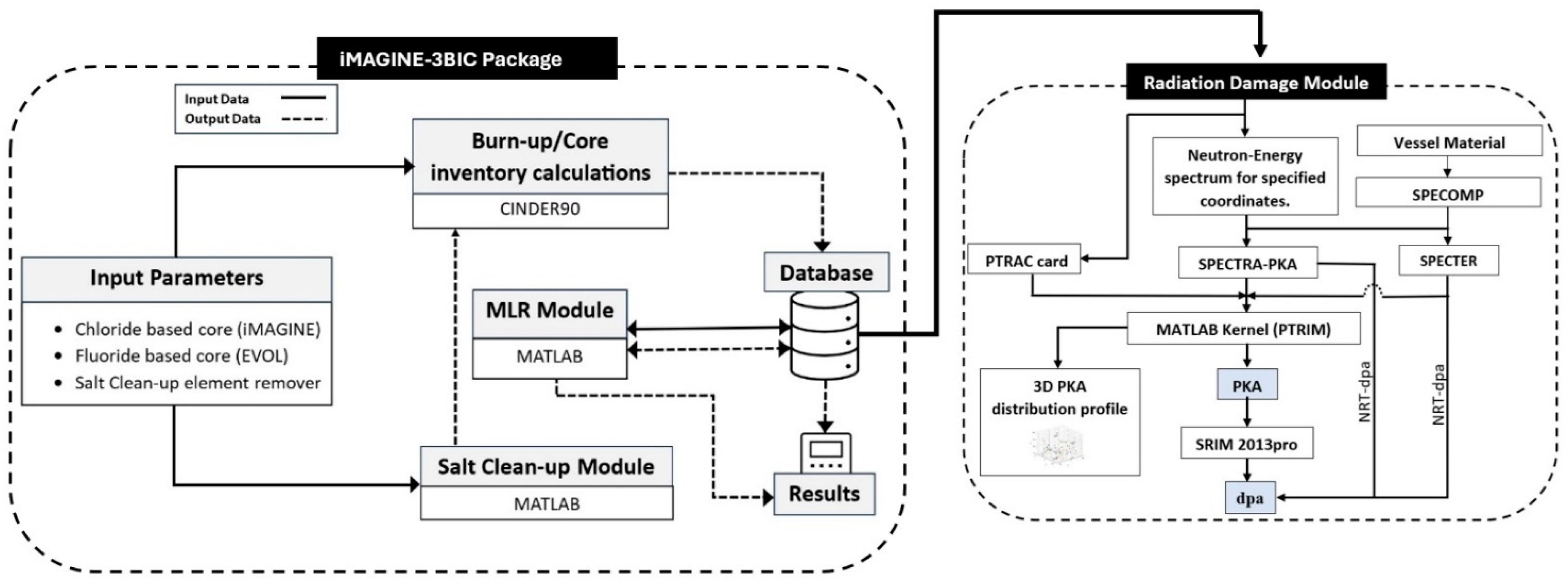

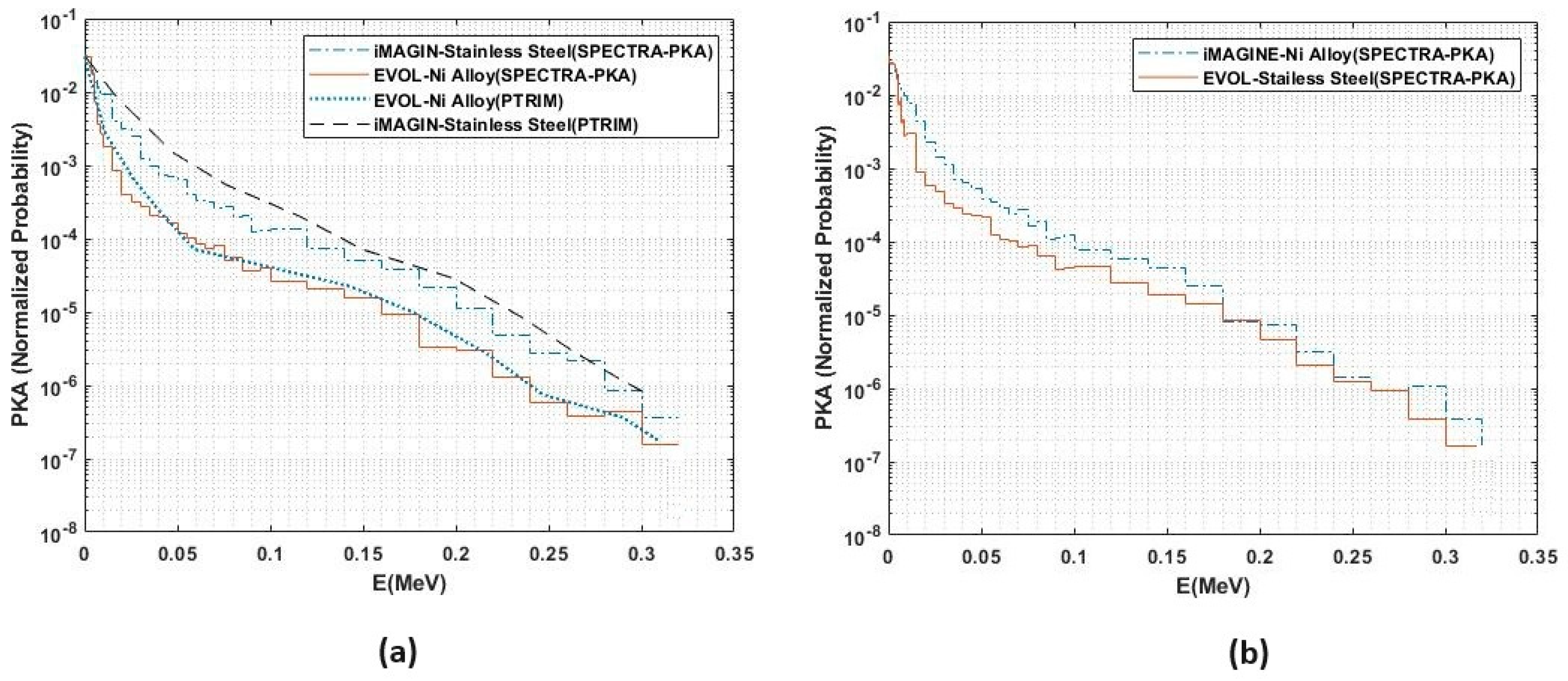
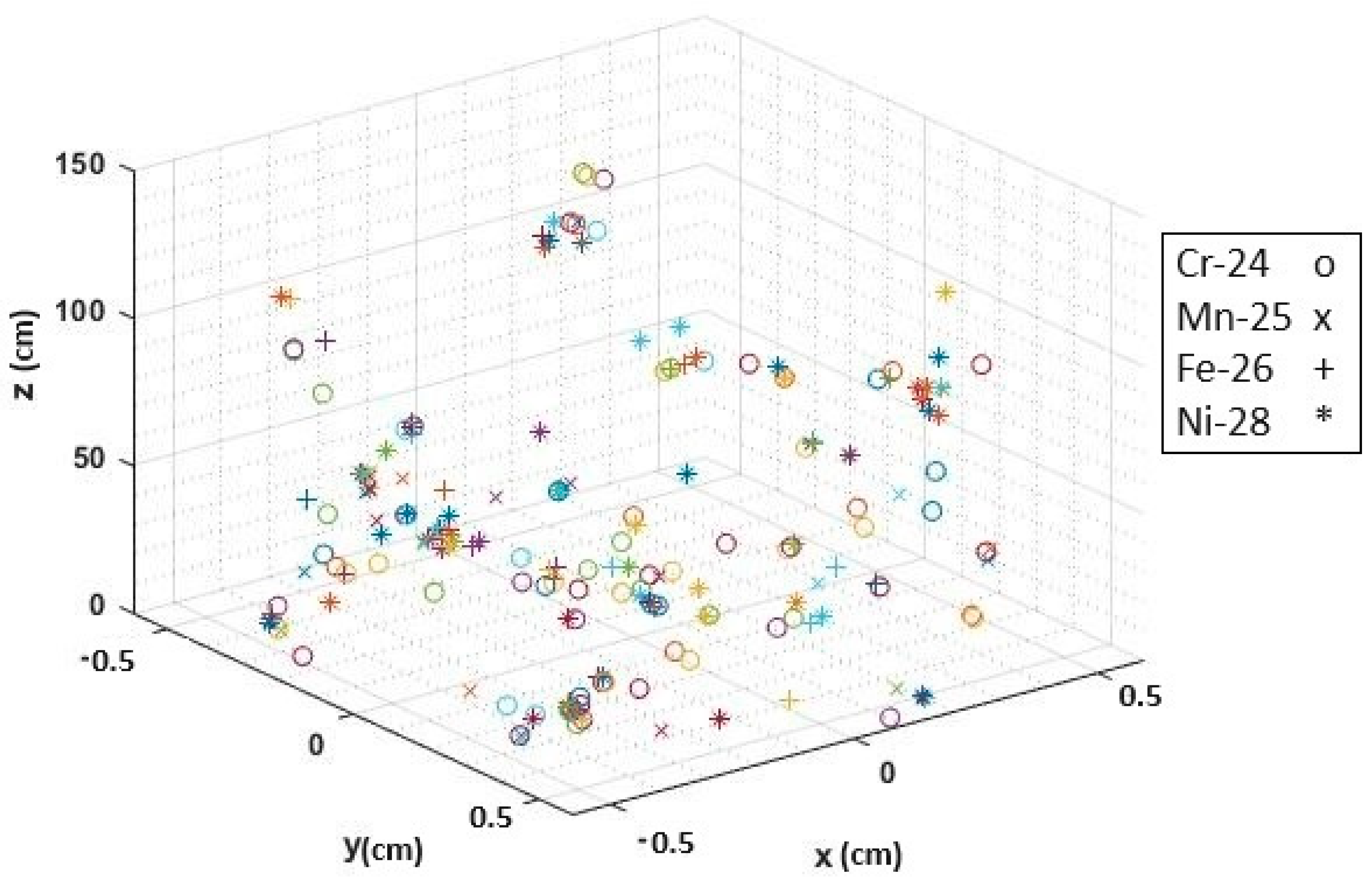


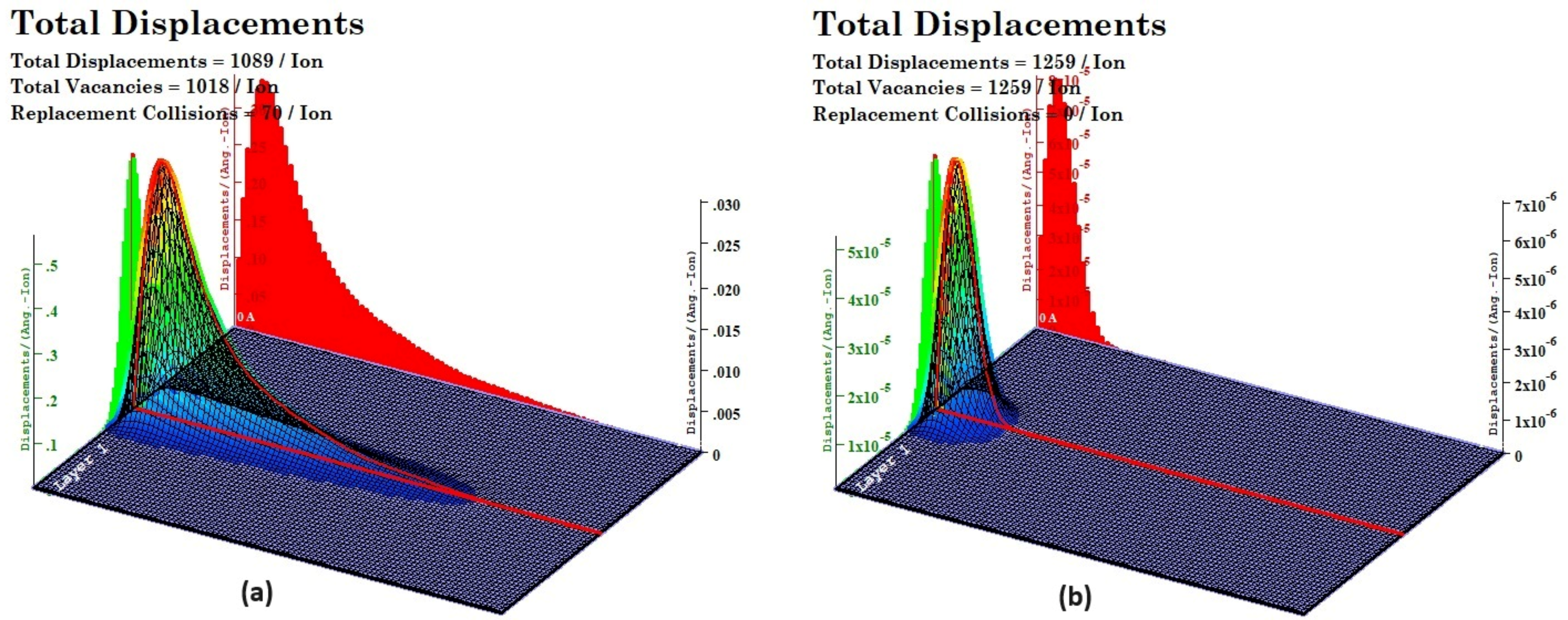
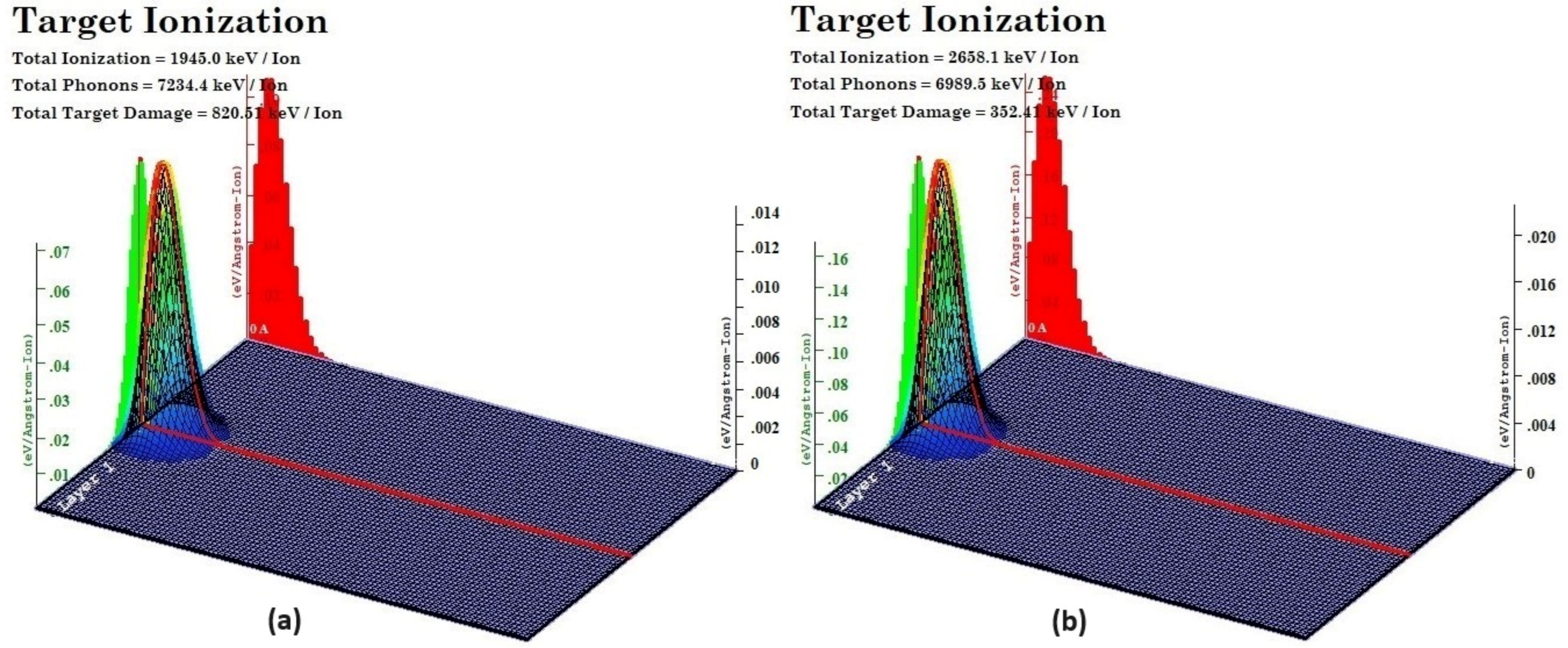
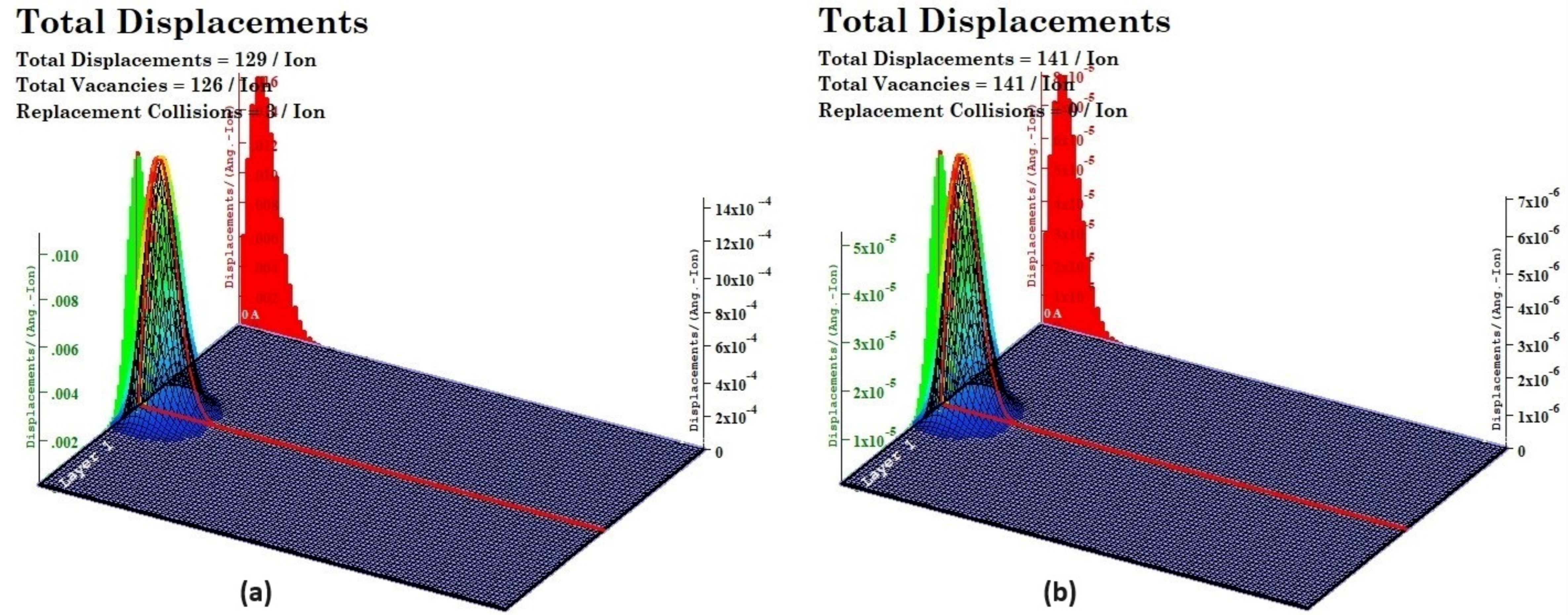
| Material | Cr | Mn | Fe | Ni | W | Mo | Ti | C | Si | Al | P | |||||||||||||||
|---|---|---|---|---|---|---|---|---|---|---|---|---|---|---|---|---|---|---|---|---|---|---|---|---|---|---|
| Mass Number | 50 | 52 | 53 | 54 | 25 | 54 | 56 | 57 | 58 | 58 | 60 | 61 | 62 | 64 | 182 | 183 | 184 | 186 | 96 | 48 | 12 | 28 | 29 | 30 | 27 | 31 |
| Stainless Steel | 0.79 | 15.9 | 1.83 | 0.46 | 2 | 3.86 | 62.84 | 1.52 | 0.2 | 6.38 | 2.56 | 0.11 | 0.36 | 0.09 | 0 | 0 | 0 | 0.08 | 0.91 | 0.05 | 0.03 | 0 | 0.05 | |||
| Ni alloy | 0.29 | 6.2 | 0.73 | 0.15 | 0 | 0 | 0.52 | 0.01 | 0 | 50.52 | 19.76 | 0 | 2.19 | 0.73 | 2.48 | 1.28 | 2.85 | 2.57 | 6.73 | 2.67 | 0 | 0.23 | 0.05 | 0.02 | ||
| Method | SPECTER | SPECTRA-PKA | PTRAC + SRIM-2013 | ||
|---|---|---|---|---|---|
| Parameter | |||||
| iMAGINE S.S vessel | Average PKA Energy(keV) | 1.3049 × 101 | 1.4108 × 101 | - | |
| dpa | 5.8817 × 101 | 5.3210 × 101 | 9.1254 × 101 | ||
| EVOL Ni alloy vessel | Average PKA Energy(keV) | 5.8504 × 100 | 6.0011 × 100 | - | |
| dpa | 4.4751 × 101 | 4.2215 × 101 | 8.2145 × 101 | ||
| Vessel Material | iMAGINE (Stainless Steel) | EVOL (Ni Alloy) | |
|---|---|---|---|
| Parameter | |||
| Neutron-Energy Spectrum | Fast (harder) | Fast (softer) | |
| Major PKA elements/Ed * (eV) | Cr (25 eV)-Fe (25 eV) | Cr (25 eV) | |
| Minor PKA elements/Ed (eV) | Ni (40 eV) | Ni (40 eV) | |
| Average PKA Energy (KeV) | SPECTER | 1.3049 × 101 | 5.8504 × 100 |
| SPECTRA-PKA | 1.4108 × 101 | 6.0011 × 100 | |
| Radiation Damage for 100 years (dpa) | SPECTER | 5.88 × 101 | 4.4751 × 101 |
| SPECTRA-PKA | 5.32 × 101 | 4.2215 × 101 | |
| PTRAC+SRIM2013 | 9.13 × 101 | 8.2145 × 101 | |
Disclaimer/Publisher’s Note: The statements, opinions and data contained in all publications are solely those of the individual author(s) and contributor(s) and not of MDPI and/or the editor(s). MDPI and/or the editor(s) disclaim responsibility for any injury to people or property resulting from any ideas, methods, instructions or products referred to in the content. |
© 2024 by the authors. Licensee MDPI, Basel, Switzerland. This article is an open access article distributed under the terms and conditions of the Creative Commons Attribution (CC BY) license (https://creativecommons.org/licenses/by/4.0/).
Share and Cite
Noori-kalkhoran, O.; Jain, L.; Merk, B. On the Use of a Chloride or Fluoride Salt Fuel System in Advanced Molten Salt Reactors, Part 3; Radiation Damage. Energies 2024, 17, 4772. https://doi.org/10.3390/en17194772
Noori-kalkhoran O, Jain L, Merk B. On the Use of a Chloride or Fluoride Salt Fuel System in Advanced Molten Salt Reactors, Part 3; Radiation Damage. Energies. 2024; 17(19):4772. https://doi.org/10.3390/en17194772
Chicago/Turabian StyleNoori-kalkhoran, Omid, Lakshay Jain, and Bruno Merk. 2024. "On the Use of a Chloride or Fluoride Salt Fuel System in Advanced Molten Salt Reactors, Part 3; Radiation Damage" Energies 17, no. 19: 4772. https://doi.org/10.3390/en17194772
APA StyleNoori-kalkhoran, O., Jain, L., & Merk, B. (2024). On the Use of a Chloride or Fluoride Salt Fuel System in Advanced Molten Salt Reactors, Part 3; Radiation Damage. Energies, 17(19), 4772. https://doi.org/10.3390/en17194772







